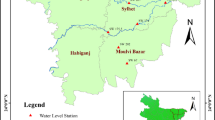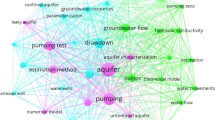Abstract
Groundwater ecosystems have unparalleled environmental value. Accurate modeling of groundwater level (GWL) fluctuations is a vital requirement for the protection of the groundwater ecosystems. The GWL modeling is a challenge due to complexities of the underground geological structure. Among the various modeling methods, artificial intelligence (AI)-based approaches serve as desirable alternatives due to their distinctive and potent properties. One of the most practical AI-based approaches is an artificial neural network (ANN) model. The purpose of the current study was to apply time delay neural networks (TDNN) with different network structures and input delays to model the GWL fluctuations. The variables used in the construction and validation of the models were average weekly GWL from January 2002 to January 2013 in two monitoring sites in Semnan/Sorkheh plain, Iran. The study area is an arid region, where overutilization of groundwater threatens the water security in this area. The computational results of the current research demonstrated that the TDNN model is a practical tool in modeling time-series GWL compared to the other state-of-the-art AI-based approaches. Future studies are recommended to explore application of proposed model for more sustainable and effective Groundwater Resources Management (GWRM).





Similar content being viewed by others
References
Banerjee, P., Prasad, R. K., & Singh, V. S. (2009). Forecasting of groundwater level in hard rock region using artificial neural network. Environmental Geology, 58(6), 1239–1246. https://doi.org/10.1007/s00254-008-1619-z.
Beale, M. H., Hagan, M. T., & Demuth, H. B. (1992). Neural network ToolboxTM 7 user’s guide. www.mathworks.com.
Bhowmik, M., Deb, K., Debnath, A., & Saha, B. (2018). Mixed phase Fe2O3/Mn3O4 magnetic nanocomposite for enhanced adsorption of methyl orange dye: Neural network modeling and response surface methodology optimization. Applied Organometallic Chemistry, 32(3), e4186.
Bhowmik, M., Debnath, A., & Saha, B. (2019). Fabrication of mixed phase CaFe2O4 and MnFe2O4 magnetic nanocomposite for enhanced and rapid adsorption of methyl orange dye: Statistical modeling by neural network and response surface methodology. Journal of Dispersion Science and Technology 1–12.
Chang, J., Wang, G., & Mao, T. (2015). ‘Simulation and prediction of suprapermafrost groundwater level variation in response to climate change using a neural network model. Journal of Hydrology, 529, 1211–1220. https://doi.org/10.1016/j.jhydrol.2015.09.038.
Daliakopoulos, I. N., Coulibaly, P., & Tsanis, I. K. (2005). Groundwater level forecasting using artificial neural networks. Journal of Hydrology, 309(1–4), 229–240. https://doi.org/10.1016/j.jhydrol.2004.12.001.
Debnath, A., Majumder, M., Pal, M., Das, N. S., Chattopadhyay, K. K., & Saha, B. (2016). Enhanced adsorption of hexavalent chromium onto magnetic calcium ferrite nanoparticles: Kinetic, isotherm, and neural network modeling. Journal of Dispersion Science and Technology, 37(12), 1806–1818.
Derbela, M., & Nouiri, I. (2020). Intelligent approach to predict future groundwater level based on artificial neural networks (ANN). Euro-Mediterranean Journal for Environmental Integration, 5(3), 1–11.
Diodato, N., & Ceccarelli, M. (2006). Computational uncertainty analysis of groundwater recharge in catchment. Ecological Informatics, 1(4), 377–389.
Ebrahimi, H., & Rajaee, T. (2017). Simulation of groundwater level variations using wavelet combined with neural network, linear regression and support vector machine. Global and Planetary Change. https://doi.org/10.1016/j.gloplacha.2016.11.014.
Gholami, V. C. K. W., Chau, K. W., Fadaee, F., Torkaman, J., & Ghaffari, A. (2015). Modeling of groundwater level fluctuations using dendrochronology in alluvial aquifers. Journal of Hydrology, 529, 1060–1069. https://doi.org/10.1016/j.jhydrol.2015.09.028.
Ghose, D., Das, U., & Roy, P. (2018). Modeling response of runoff and evapotranspiration to predict water table depth in arid region using dynamic recurrent neural network. Groundwater for Sustainable Development, 6, 263–269. https://doi.org/10.1016/j.gsd.2018.01.007.
Griebler, C., & Avramov, M. (2014). Groundwater ecosystem services: A review. Freshwater Science, 34(1), 355–367.
Iranian Meteorological Organization. (2016). Weather statics and records of Arak, Markazi, Iran. http://www.irimo.ir/index.php?newlang=eng.
Kaiser, M. (1994). Time-delay neural networks for control. IFAC Proceedings Volumes, 27(14), 967–972.
Kamalan, H., Khoshand, A., & Tabiatnejad, B. (2009). An investigation on efficiency of MTBE removal from water by adsorption to porous soil. In 2009 2nd international conference on environmental and computer science (pp. 360–363).
Khoshand, A., Fathi, A., Zoghi, M., & Kamalan, H. (2018). Seismic stability analyses of reinforced tapered landfill cover systems considering seepage forces. Waste Management & Research, 36(4), 361–372.
Kouziokas, G. N., Chatzigeorgiou, A., & Perakis, K. (2018). Multilayer feed forward models in groundwater level forecasting using meteorological data in public management. Water Resources Management, 32(15), 5041–5052. https://doi.org/10.1007/s11269-018-2126-y.
Lee, S., Lee, K. K., & Yoon, H. (2019). Using artificial neural network models for groundwater level forecasting and assessment of the relative impacts of influencing factors. Hydrogeology Journal, 27(2), 567–579. https://doi.org/10.1007/s10040-018-1866-3.
Malik, A., & Bhagwat, A. (2021). Modelling groundwater level fluctuations in urban areas using artificial neural network. Groundwater for Sustainable Development, 100484.
Mohanty, S., Jha, M. K., Kumar, A., & Sudheer, K. P. (2010). Artificial neural network modeling for groundwater level forecasting in a river island of eastern India. Water Resources Management, 24(9), 1845–1865. https://doi.org/10.1007/s11269-009-9527-x.
Mohanty, S., Jha, M. K., Raul, S. K., Panda, R. K., & Sudheer, K. P. (2015). Using artificial neural network approach for simultaneous forecasting of weekly groundwater levels at multiple sites. Water Resources Management, 29(15), 5521–5532. https://doi.org/10.1007/s11269-015-1132-6.
Mohd Nawi, N., Atomia, W. H., & Rehman, M. Z. (2013). The effect of data pre-processing on optimized training of artificial neural networks. Procedia Technology, 11, 32–39.
Nayak, P. C., Satyaji Rao, Y. R., & Sudheer, K. P. (2006). Groundwater level forecasting in a shallow aquifer using artificial neural network approach. Water Resources Management, 20(1), 77–90. https://doi.org/10.1007/s11269-006-4007-z.
Rajaee, T., Ebrahimi, H., & Nourani, V. (2019). A review of the artificial intelligence methods in groundwater level modeling. Journal of Hydrology. https://doi.org/10.1016/j.jhydrol.2018.12.037.
Ravansalar, M., & Rajaee, T. (2015). Evaluation of wavelet performance via an ANN-based electrical conductivity prediction model. Environmental Monitoring and Assessment. https://doi.org/10.1007/s10661-015-4590-7.
Roshni, T., Jha, M. K., & Drisya, J. (2020). Neural network modeling for groundwater-level forecasting in coastal aquifers. Neural Computing and Applications, 32, 12737–12754.
Sahoo, S., & Jha, M. K. (2013). Groundwater-level prediction using multiple linear regression and artificial neural network techniques: A comparative assessment. Hydrogeology Journal, 21(8), 1865–1887. https://doi.org/10.1007/s10040-013-1029-5.
Salehnia, N., Ansari, H., Kolsoumi, S., & Bannayan, M. (2019). Climate data clustering effects on arid and semi-arid rainfed wheat yield: A comparison of artificial intelligence and K-means approaches. International Journal of Biometeorology, 63(7), 861–872. https://doi.org/10.1007/s00484-019-01699-w,63(7):pp.861-872.
Sang, Y. F., Wang, Z., & Liu, C. (2015). Wavelet neural modeling for hydrologic time series forecasting with uncertainty evaluation. Water Resources Management, 29(6), 1789–1801.
Sreekanth, P. D., Sreedevi, P. D., Ahmed, S., & Geethanjali, N. (2011). Comparison of FFNN and ANFIS models for estimating groundwater level. Environmental Earth Sciences, 62(6), 1301–1310. https://doi.org/10.1007/s12665-010-0617-0.
Sugiyama, M., Sawai, H., & Waibel, A. H. (1991). Review of TDNN (time delay neural network) architectures for speech recognition. In IEEE international symposium on circuits and systems (pp. 582–585).
Sun, Y., Wendi, D., Kim, D. E., & Liong, S. Y. (2016). Application of artificial neural networks in groundwater table forecasting-a case study in a Singapore swamp forest. Hydrology and Earth System Sciences, 20(4), 1405–1412. https://doi.org/10.5194/hess-20-1405-2016.
Taormina, R., Chau, K. W., & Sethi, R. (2012). Artificial neural network simulation of hourly groundwater levels in a coastal aquifer system of the Venice lagoon. Engineering Applications of Artificial Intelligence, 25(8), 1670–1676. https://doi.org/10.1016/j.engappai.2012.02.009.
Torres-Perez, J., Huang, Y., Bazargan, A., Khoshand, A., & McKay, G. (2020). Two-stage optimization of Allura direct red dye removal by treated peanut hull waste. SN Applied Sciences, 2(3), 1–12.
Tutmez, B. (2009). Assessing uncertainty of nitrate variability in groundwater. Ecological Informatics, 4(1), 42–47.
Wagh, V., Panaskar, D., Muley, A., Mukate, S., & Gaikwad, S. (2018). Neural network modelling for nitrate concentration in groundwater of Kadava River basin, Nashik, Maharashtra, India. Groundwater for Sustainable Development, 7, 436–445. https://doi.org/10.1016/j.gsd.2017.12.012.
Waibel, A., Hanazawa, T., Hinton, G., Shikano, K., & Lang, K. J. (1989). Phoneme recognition using time-delay neural networks. IEEE Transactions on Acoustics, Speech, and Signal Processing, 37(3), 328–339.
Wang, G. (2019). Machine learning for inferring animal behavior from location and movement data. Ecological informatics, 49, 69–76.
Yoon, H., Jun, S. C., Hyun, Y., Bae, G. O., & Lee, K. K. (2011). A comparative study of artificial neural networks and support vector machines to predict groundwater levels in a coastal aquifer. Journal of Hydrology, 396(1–2), 128–138. https://doi.org/10.1016/j.jhydrol.2010.11.002.
Zhang, J., Zhang, X., Niu, J., Hu, B. X., Soltanian, M. R., Qiu, H., & Yang, L. (2019). Prediction of groundwater level in seashore reclaimed land using wavelet and artificial neural network-based hybrid model. Journal of Hydrology, 577, 123948.
Author information
Authors and Affiliations
Corresponding author
Additional information
Publisher's Note
Springer Nature remains neutral with regard to jurisdictional claims in published maps and institutional affiliations.
Rights and permissions
About this article
Cite this article
Khoshand, A. Application of artificial intelligence in groundwater ecosystem protection: a case study of Semnan/Sorkheh plain, Iran. Environ Dev Sustain 23, 16617–16631 (2021). https://doi.org/10.1007/s10668-021-01361-9
Received:
Accepted:
Published:
Issue Date:
DOI: https://doi.org/10.1007/s10668-021-01361-9




